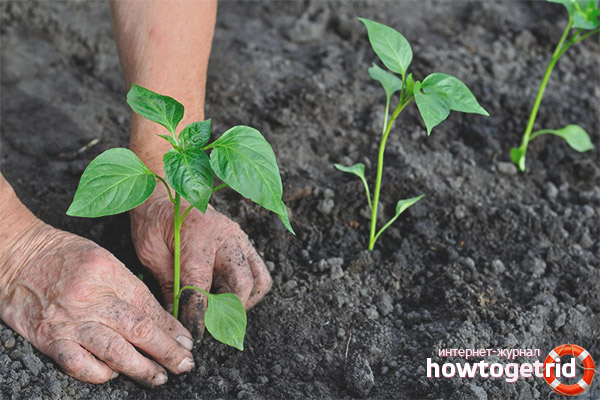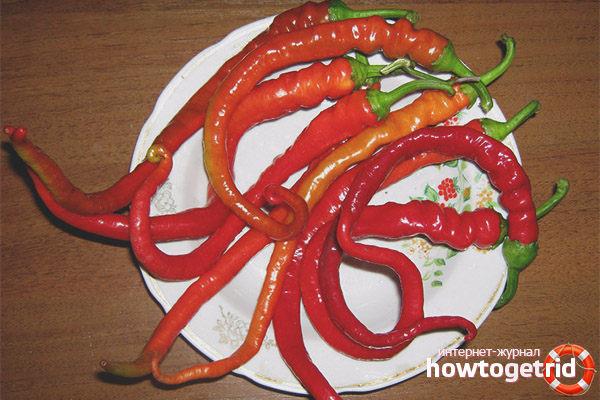The content of the article
Pepper Python is one of the most unusual types of sweet pepper. The fruits are elongated, proboscis, sometimes twisted into a bagel. With biological maturation, the pods acquire a bright red color, the skin is glossy, shiny. The fruits are absolutely not bitter, crispy and very fragrant.
Grade description
Novice gardeners confuse this variety with hot pepper because of the external similarities. The advantages of the variety include high productivity, excellent preservation after picking, and high transportability.
Python ripens very early, this is one of the earliest ripe varieties of bell pepper. Fruiting continues until the first autumn frosts. This culture can be grown indoors, a flowering and fruiting plant looks very decorative. With proper care and a favorable climate, up to seven kilograms of product can be collected from one bush.
Growing seedlings
This variety of pepper is grown only in seedling method.
First of all, you need to prepare the soil mixture. The soil should be fertile, light and structured. To prepare the soil mixture, take humus, chernozem, peat, sand and ash.
Sow seeds in shallow containers with holes to drain excess moisture. Purchase seeds only from trusted suppliers, in special stores.
Before sowing, check germination, decontaminate the seed. You can treat the grain with a solution of growth stimulant and fungicide.
Do not close the seeds too deep, just sprinkle them with a thin layer of soil.
After sowing the seeds, pour the soil, cover with a film to create a greenhouse effect.
In the first few days, the presence of sunlight is not necessary, there will be enough heat and moisture. After germination, transfer the seedling container to the windowsill. Seedlings will need a large amount of solar energy.
When growing seedlings in late February, you will definitely need to light the seedlings with special lamps, since the daylight hours in this period of the year are not long enough.
DO NOT sow seeds too densely, seedlings are elongated during thickened crops, plants lack sunlight and nutrients. Overgrown, elongated seedlings do not tolerate transplantation, take root for a long time, and are sick for a long time. Such plants will never bring a high yield.
Seedlings are fed at the age of 2-3 weeks with nitrogen fertilizers, which stimulate the growth of the vegetative mass.
Remember that pepper is a thermophilic plant that does not tolerate drafts and lower temperatures to 8-9 degrees. After short-term exposure to low positive temperatures, bell pepper freezes, stops growing for a very long time.
At the stage of 3-4 leaves, seedlings are necessarily dive, followed by transplantation into separate cups or pots.
Transplanting

Do not rush to plant pepper seedlings in open ground, wait for stable warm weather. Remember that even a short-term cooling can destroy young, non-hardened plants.
When planting seedlings, take out a plant with a lump of earth, pepper roots are easily injured, they take root poorly, not at all like tomatoes.
Compost, rotted manure, wood ash should be added to the planting holes or furrows. After planting, plants are abundantly watered under the root. You can cover the seedlings with agrofibre to protect the foliage from sunburn and gusts of wind.
It is recommended to mulch the soil with hay or sawdust.Under the mulch, earthworms and insects are activated, which help to loosen the soil, saturating it with oxygen. In addition, the mulch layer traps moisture in the surfaces of the layers. Watering is carried out 2-3 times a week. Pepper does not like stagnation of moisture, the roots can rot and develop rot.
Cultivation and care
It is important to feed the plant in a timely manner. The first time fertilizers are applied a week after planting. Pepper is very responsive to organic fertilizers. Organic fertilizer consumption (mullein solution 1/10 or bird droppings solution 1/20, respectively).
Pepper Python has the property of overgrowing bushes. With strong growth, large leaves must be removed.
Fusarium-affected bushes are sprayed with 1% Bordeaux liquid with the addition of colloidal sulfur.
Pepper Python is not a hybrid, so you can collect its seeds for growing on the site in subsequent years.
Video: growing pepper from A to Z










Submit